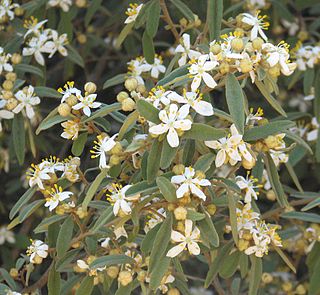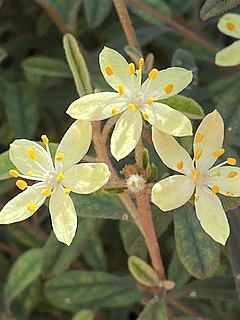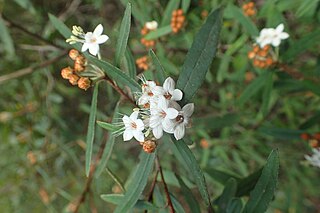
Asterolasia is a genus of seventeen species of erect or prostrate shrubs in the family Rutaceae, and is endemic to Australia. The leaves are simple and arranged alternately, the flowers arranged in umbel-like groups on the ends of branchlets or in leaf axils, usually with five sepals, five petals and ten to twenty-five stamens. There are seventeen species and they are found in all Australian mainland states but not in the Northern Territory.

Phebalium whitei is a small shrub that is endemic to south-east Queensland. It has branchlets covered with silvery and rust-coloured scales, leathery, oblong to elliptic leaves and bright yellow flowers arranged in sessile umbels on the ends of branchlets.

Phebalium stenophyllum, commonly known as narrow-leaved phebalium, is a species of small shrub that is endemic to south-eastern Australia. It has scaly branchets, narrow oblong to more or less cylindrical leaves and yellow flowers in umbels of three to ten.

Asterolasia hexapetala is a species of erect, spreading shrub that is endemic to the Warrumbungles in New South Wales. It has oblong to elliptical leaves with star-shaped hairs, especially on the lower surface, and white flowers arranged in small groups in leaf axils and on the ends of branchlets, the back of the petals densely covered with white, yellow or brown, woolly star-shaped hairs.

Phebalium squamulosum , commonly known as scaly phebalium or forest phebalium, is a species of shrub or slender tree that is endemic to eastern Australia. It has smooth branches covered with rust-coloured scales, linear to elliptical or egg-shaped leaves with the narrower end towards the base, and pale to bright yellow flowers in umbels with rust-coloured or silvery scales on the back.

Phebalium nottii, commonly known as pink phebalium, is a species of shrub that is endemic to eastern Australia. It has branchlets with silvery scales, oblong to elliptical leaves, deep pink to mauve flowers arranged in umbels of up to six, with the stamens distinctively offset to one side of the flower.

Asterolasia asteriscophora, commonly known as lemon starbush, is a species of slender, erect shrub in the family Rutaceae and is endemic to southern continental Australia. It has woolly, star-shaped hairs on its young branches, variably-shaped leaves covered with brownish or whitish hairs on the underside, and yellow flowers with woolly brown, star-shaped hairs on the back.

Asterolasia elegans is a species of slender, erect shrub that is endemic to a restricted area of New South Wales. It has dense, woolly, rusty star-shaped hairs on its stems, lance-shaped leaves densely covered with white and rust-coloured hairs on the lower surface, and white flowers arranged singly or in groups of up to nine in leaf axils or on the ends of branchlets, the back of the petals densely covered with woolly, white hairs.
Phebalium drummondii is a species of small shrub that is endemic to Western Australia. It has smooth branchlets covered with silvery scales, broadly elliptic to egg-shaped leaves with silvery scales on the lower side and bright yellow flowers arranged in umbers on the ends of branchlets.

Phebalium obcordatum, commonly known as the club-leaved phebalium, is a species of shrub that is endemic to New South Wales. It has smooth branchlets, small egg-shaped to heart-shaped leaves with the narrower end towards the base and small umbels of pale yellow flowers with silvery scales on the back of the petals.

Phebalium tuberculosum is a species of erect shrub that is endemic to Western Australia. It has glandular-warty and scaly branchlets and leaves and white flowers arranged in umbels of three or four with rust-coloured scales on the back of the petals.

Phebalium woombye, commonly known as wallum phebalium, is a species of shrub that is endemic to eastern Australia. It has branchlets covered with scales and star-shaped hairs, elliptical leaves, and white to pink flowers arranged in umbels of four to ten flowers.

Asterolasia buckinghamii is a species of slender, erect shrub in the family Rutaceae and is endemic to eastern New South Wales. It has star-shaped hairs on its young branches, broadly egg-shaped, hairy leaves and yellow flowers with rust-coloured, star-shaped hairs on the back of the petals.
Asterolasia buxifolia is a species of spindly shrub in the family Rutaceae and is endemic to a restricted area of eastern New South Wales. It has star-shaped hairs on its stems, leathery leaves and yellow flowers arranged singly in leaf axils with star-shaped hairs on the back of the petals.

Asterolasia correifolia is a species of erect shrub that is endemic to eastern Australia. It has white to brown star-shaped hairs on its stems, lance-shaped to elliptical leaves densely covered with white star-shaped hairs on the lower surface, and white to cream-coloured or yellow flowers arranged in umbels of four to ten or more in leaf axils, the back of the petals densely covered with white hairs.

Asterolasia drummondii, commonly known as Gairdner Range starbush, is a species of small shrub that is endemic to a restricted area of the southwest of Western Australia. It has egg-shaped leaves and white flowers arranged in umbels of five to ten flowers with rust-coloured, star-shaped hairs on the back of the petals.

Asterolasia grandiflora is a species of weak, open shrub or sub-shrub that is endemic to the southwest of Western Australia. It has oblong, elliptical or egg-shaped leaves and pink to mauve flowers arranged in umbels of about three flowers with a thick covering of star-shaped hairs on the back of the petals.
Asterolasia muricata, commonly known as lemon star-bush, is a species of small, slender, erect shrub that is endemic to South Australia. It has leathery leaves covered with rough points and with the edges rolled under, and yellow flowers arranged singly or in groups of up to three, with woolly star-shaped hairs on the back of the petals.

Asterolasia pallida is a species of woody, perennial herb that is endemic to the southwest of Western Australia. It has elliptical leaves and white flowers arranged in umbels of three to six with star-shaped hairs on the back of the petals and fifteen to twenty-five stamens.

Asterolasia rupestris is a species of erect shrub that is endemic to New South Wales. It has heart-shaped to triangular leaves with the narrower end towards the base, and densely covered with star-shaped hairs. The flowers are yellow and arranged singly or in groups of three to six in leaf axils or on the ends of branchlets, the back of the petals densely covered with rust-coloured, star-shaped hairs.
















